Effective functioning heating system possible only if the equipment is correctly selected and installed correctly. To avoid accidents during its operation, before starting work, you should not only carefully study all its nuances, but also get detailed advice from an experienced specialist.
Calculation of boiler power
Regardless of the type of fuel used (solid or liquid, gas or electricity), the principle of connecting all heating systems is the same. The difference is only at the stage of boiler installation. In this case, the calculation of its power is made according to a single formula:where W is the specific power required for heating 10 sq. m premises;
S is the total area of \u200b\u200bthe house.
For Russian regions, the following power values \u200b\u200bare taken into account:
for houses located in central Russia up to 1.5 kW;
for Siberia and the North: for every 10 sq. m up to 2 kW;
for southern regions: up to 0.9 kW.
Since sufficient heating is 10 sq. m of a residential building located in central Russia requires up to 1.5 kW of power, then, for example, for heating 100 sq. m you will need a 15 kW boiler:
(100 x 1.5) / 10 \u003d 15 kW
This figure is increased by 15-20% (power reserve for possible heat loss, which is inevitably lost even with ideal building insulation). Thus, for heating a house of 100 sq. m will need (15 + 2.3) \u003d 17.3 kW.
Calculation of the number of radiators
Since to ensure sufficient heating 1 sq. m of the room will require 100 W of battery power, to calculate them total capacity the area of \u200b\u200bthe heated room should be multiplied by 100. (When purchasing radiators, their power should be seen in the documentation attached to them).Important! With a ceiling height of 3 m, when calculating both the number of radiators and the volume of the boiler, not the area of \u200b\u200bthe room is used, but its volume.
20 x 100 \u003d 2000 W or 2.0 kW.
Moreover, in the presence of:
one window and two end walls, this figure will increase by 20%;
two windows and two outer walls - by 30%;
the exit of windows to the north - another 10%.
If the battery shuts down decorative panel, this figure increases by another 15%. Since radiators inevitably become clogged over time, a margin of 15-20% is added to this value. It is better to install additional sections in corner rooms, which are heated worse.
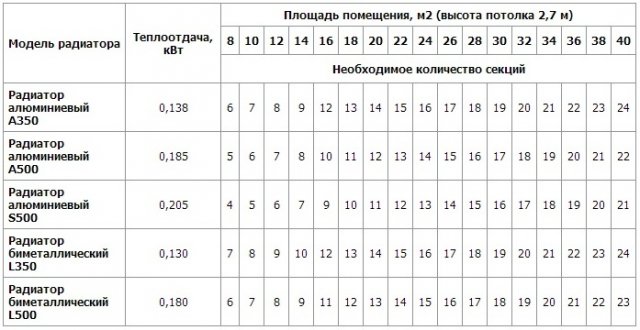
Calculation table for the required number of sections
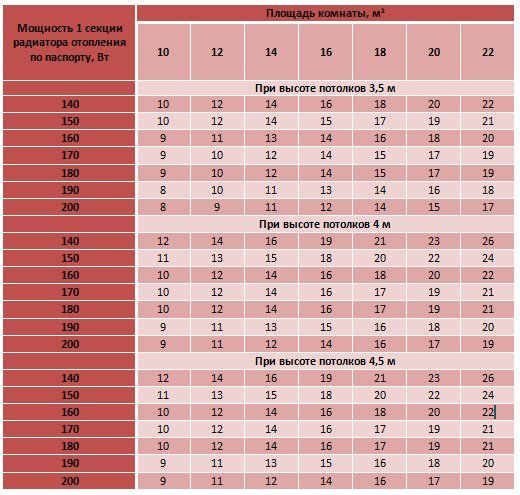
Calculation of the number of sections with a ceiling height of more than 3.0 m
Heating systems diagrams
The simplest and most commonly used heating system is heating with natural fluid circulation... The principle of its operation is simple: the water or antifreeze heated in the boiler, expanding, is pushed along the main line, and then, cooling down, returns to the boiler, where it is again heated to the required temperature.For the normal functioning of such a system, it is necessary to ensure both the slope of the return towards the boiler up to 5 1 per 1 m of the line, and the slope of the supply. (Return is called the pipeline through which water or antifreeze returns to the boiler). You may need to slightly lower the floors in the boiler room for this. In order for the circulation of the coolant to be ideal, the return line must be located below the level of the radiators. Failure to comply with all these requirements can lead to insufficient heating of the radiators due to the constant formation of air locks.

Diagram of a natural circulation system
The most important element of such a system is the expansion tank, into which the excess of the coolant (water or antifreeze) arising from its expansion due to heating is discharged. It is installed at the highest point of the system - under the ceiling of the boiler room or in the attic. When installing such a tank in attic it is carefully insulated.
Its volume is determined by the formula:
The amount of heat carrier in the system x Coefficient 0.08.
For example, if 100 liters of liquid are pumped into the system, then the volume of the tank will be 100 x 0.08 \u003d 8 liters.
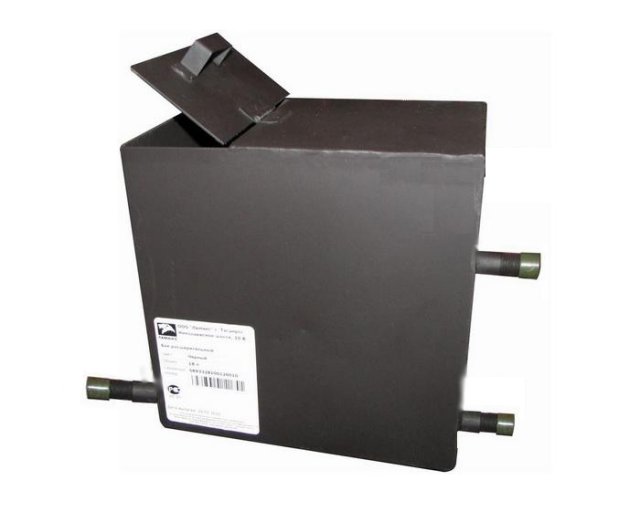
Open type expansion tank
When forced circulation the slope of the pipelines is not necessary, since the circulation of the liquid is provided by the pump. In this case, instead of expansion tank better use hydroaccumulator (membrane tank), which will not only be able to protect the system from water hammer when the pump is turned on and off, but will also regulate the frequency of its activation as the tank is empty.
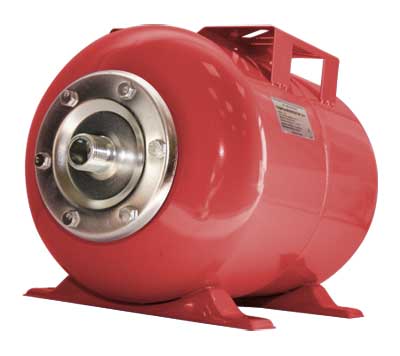
Hydroaccumulator
Important! The maximum temperature for the smooth operation of the circular pump is 70 ° C. That is why, in order to avoid overheating, they put it only for return, in which the water temperature is lower than in the system.
The heating of pipes in such a system is increased by 30%, which can significantly save fuel. Without forced circulation, it is impossible to ensure uniform water supply in two-story houses.
Important! When installing the pump, mandatory installation is required bypass (bypass line) - jumpers between pipes, equipped with shut-off and control valves (valves).
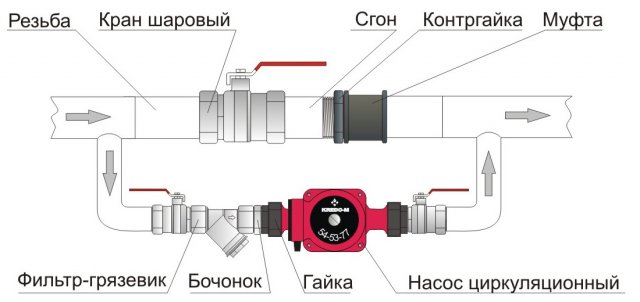
Circular pump installation

Bypass with three shut-off and control valves for the circulation pump
Types of trunk wiring
One pipe system, in which all radiators are connected using one pipe, today is considered morally obsolete and rarely used. Its disadvantage is the uneven heating of the rooms. As the water moves from the battery to the battery, the liquid gradually cools down, and it comes to the last room almost completely cold.
One-pipe heating system
You can slightly correct the situation by adding bypasses (lintels between pipes) equipped with control valves... This construction is called "Leningrad".

Heating system "Leningradka"
However, a better option is two-pipe system , in which the hot coolant goes through the upper pipe, and the cooled liquid returns back through the second pipe. This method can be used in both forced and natural circulation systems.
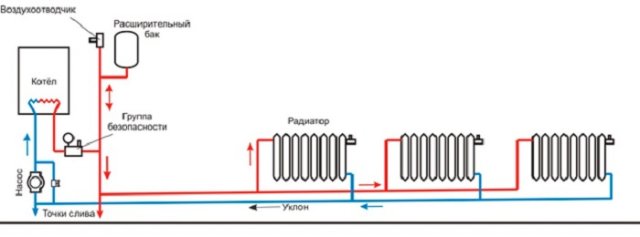
Two-pipe system
Collector system is a more complex option and is rarely used, mainly when equipping multi-storey buildings large area. The heat carrier in it is distributed evenly throughout the system, while the heating intensity of each radiator can be adjusted. Sometimes this method is called ray.

Collector device

Collector (beam) wiring
Connecting radiators
The choice of the method of their connection depends on their total number, the method of laying, the length of pipelines, etc. The most common methods are:diagonal (cross) method: the straight pipe is connected to the side of the battery at the top, and the return pipe is connected to its opposite side at the bottom; this method allows the heat carrier to be distributed over all sections as evenly as possible with minimal heat loss; used with a significant number of sections;
unilateral: it is also used with a large number of sections, a hot water pipe (straight pipe) and a return pipe are connected on one side, allowing for sufficient uniformity of heating of the radiator;
saddle: if the pipes go under the floor, it is most convenient to fix the pipes to the lower branch pipes of the battery; due to the minimum number of visible pipelines it looks attractive outwardly, however, the radiators heat up unevenly;
lower: the method is similar to the previous one, the only difference is that the straight pipe and return pipe are located practically at the same point.

Radiator connection methods
To protect against cold penetration and create a thermal curtain, batteries are located under the windows. In this case, the distance to the floor should be 10 cm, from the wall - 3-5 cm.
System installation procedure
The heating system is assembled in the following sequence:boiler installation;
piping and connecting them to batteries;
the device of an expansion tank or hydraulic accumulator;
installation of a circular pump;
connecting the boiler to the assembled system.
In a private house, it is better to use single-circuit boilersheating water only for heating. Using double-circuit boilers, in which, in addition to heating the radiators, water will be heated for taking a shower or bath, washing dishes, etc., it seems inappropriate, since too much scale will form in the pipes. For getting warm water for household needs it is better to purchase an electric boiler.
If you plan to install two boilers: solid fuel and electric, it is better to connect them in series. In this case, if the solid fuel boiler cools down, the electric boiler control system will automatically turn on in operation. In this case, the piping can be any.
Since air locks are very often formed in the places of pipe bends, if it is impossible to minimize their number, it is recommended to install additional valves for air release. AT aluminum radiators due to the reaction of aluminum with the coolant, plugs are formed much more often, therefore, it is imperative to install on such radiators air vents.
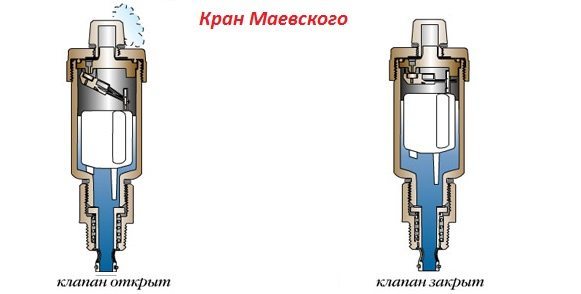
Air vents (Mayevsky taps)
Owners of country houses very often face the problem of water supply to their homes - unfortunately, in the province, there is no centralized water supply at all, or its quality, to put it mildly, is unsatisfactory. The medieval conditions of the "bucket" water supply from the nearest well, of course, do not correspond to even the most minimal modern concepts of comfort. There is only one way out - the homeowner must attend to the arrangement of a full-fledged autonomous water supply. Fortunately, such systems are already operating successfully in many regions of our country.
How is the autonomous water supply system arranged? To put it simply, it consists of devices that supply water (pump, well) and devices for water treatment (purification filters, water heaters). Also, the autonomous water supply system includes pumped storage tanks, automatic pump control systems, devices that maintain pressure in heating systems, etc. This whole kit costs a lot of money: to ensure a perfect autonomous water supply at home, an amount of $ 10,000-20,000 may be required, and this, as they say, is not the limit.
The cost of autonomous water supply systems largely depends on the specific features of the land plot: the level of occurrence of a suitable aquifer and the degree of mineralization of the water contained in it. Also, the cost of a "private water supply" is influenced by the maximum water flow for which it is designed. The higher the consumption, the more money will have to be paid for the water supply system, and the amount grows exponentially.
We dance from the well
The main source of water for autonomous water supply systems are wells drilled "on limestone" - to the level of occurrence of water-saturated calcareous rocks, located, as a rule, at a depth of 40-250 m, and "on sand" - to the level of occurrence of water-saturated sands, with a depth of 10 40 m. Lime wells have a lot of advantages over sand wells:
- The service life of these wells is 20, 30 and more years. Wells drilled "on the sand", of course, will cost much less, but they are short-lived and fail in 4-6, maximum 8 years due to clogging with soil particles;
- Only lime wells are able to provide a stable water flow rate, which will not noticeably decrease over time, and not depend on the season of the year. Sand wells cannot guarantee the same stability;
- Water from lime wells does not change its biochemical composition over time. This is especially important (even if there is a high-quality water treatment system) - water from sandy wells can suddenly become contaminated by various "sources" from the surface of the earth. For example, you drilled a well, analyzed the water and selected filters - and a month later, a neighbor built a septic tank and begins to discharge wastewater to "your" aquifer.
Recently, the state is also concerned about the problem of supplying people with quality water. After the tragic events associated with the cholera epidemic in Tatarstan, the state program "Drinking Water" was developed, which directly states that only groundwater should be used as a source of drinking water, not groundwater. Groundwater is recommended for use for domestic water supply in most developed countries of Europe and the USA. The conclusion is obvious: if you are building a house that you intend to use for many years, long-lasting and reliable lime wells are best used as a water source. In the future, we will focus exclusively on them. Of course, if you need water of "unknown quality" and for a short period of time, you can get by with a sandy well, and even easier - use the so-called "open water intake": a river, a lake, a well.
The price of "life-giving moisture"
Water-saturated limestones occur over most of the territory of our country. The only exception, perhaps, are the "places of emergence of bedrock vapor-forming rocks", in other words, mountains. But the depth of the occurrence of aquiferous limestones in different areas is different, hence there are significant fluctuations in the cost of drilling. Wells with a depth of 40-60 meters will cost the customer $ 30-50 per linear meter, the cost running meter wells with a depth of over 100 meters reach $ 80-100, the technology used for drilling is also important (this will be discussed below). Thus, a "one and the same" lime hole will cost from $ 1200 to $ 25000. The depth of the well (and, accordingly, the cost) is influenced by the depletion of the upper aquiferous lime layer and its relative pollution - similar phenomena are typical for densely populated areas with a developed industrial infrastructure. Alas, the Moscow region can be safely attributed to such areas, the upper limestone aquifer in many of its places is already unusable, deeper wells have to be drilled. Of course, not every inhabitant from the province can afford to spend several tens of thousands of dollars on a (even if very good) water supply system. This is used by unscrupulous construction crews who sometimes undertake to drill wells for significantly less money. Unfortunately, attempts to save money by attracting such "flying Dutchmen" often end in failure - wells soon stop working, the water in them becomes polluted and becomes unusable. After a year or two, the owner has no choice but to turn to other builders again so that they can drill a new well for him.
It is possible to distinguish conscientious builders from hack workers by the drilling technology they use. Sabbath workers, working quickly, cheaply and of poor quality, lay pipes in the well to the upper layers of limestone, and in limestone they continue drilling with an open hole to the water-saturated layer. After water appears in the well, the well is pumped for several hours, and when clear water begins to flow, a bottle with it is solemnly handed over to the customer. "Everything, the work is over.
At the same time, the builders are not at all embarrassed by the fact that limestone is a soft rock that very easily crumbles into the wellbore. Over time, a gap may form between the pipes and the ground, through which contaminated water from the upper sandy horizons enters the limestone. The well is silted up, its productivity decreases, the water quality becomes unacceptable due to the increase in the number of microorganisms. Sometimes unfortunate builders prefer to connect pipes in a well by welding, which is unacceptable. Welds easily corrode and degrade, acting as “additional” sources of pollution. Pipes in the well can only be connected with a threaded connection.
Thus, a lime well drilled in some way is not much better than a well drilled in sand. The most unpleasant thing is that the quality of water in it deteriorates gradually, unnoticed by its owners. Water analysis done shortly after drilling can give excellent results, but there is no guarantee that all indicators will remain normal after several years of operation.
More responsible builders take into account the chipping of limestone and prevent its destruction as follows. The well is drilled to limestone, metal pipe, and then a certain amount of cement slurry is pumped into it, which "seals" possible cracks in the limestone, preventing it from collapsing. This method significantly reduces the likelihood of well siltation and contaminated water mixing into it. The usual warranty for such wells is five years.
However, even a cement pad does not always help. Sometimes limestone is so loose that even local strengthening of it with cement does not prevent spalling. The only way to avoid "downhole problems" with 100% probability is to use European drilling technology. In this technology, a metal casing string of a larger than usual diameter is placed on limestone, lower, in the limestone a well is drilled already of a usual diameter. A production string made of food grade plastic with a perforated surface is placed in a metal string, and the annular gap is filled in the lower part of the pipe with a layer of selected fine gravel, and in the upper part with a layer of special clay "compactonite". Gravel protects the well from siltation, playing the role of a filter, and compactonite, which has the property of increasing in volume under the influence of moisture, plays the role of a sealed plug, tightly blocking the access to the lime layers of polluted water from the upper horizons. This technology ensures well operation for tens of years, only one warranty period for such a well is 30 years.
In addition to purely technical problems, any potential organizer of autonomous water supply will face the need to resolve a number of legal issues. To drill wells for limestone, it is necessary to obtain a permit for drilling operations, coordinated with environmental organizations. The cost of the entire package of "permitting" documents is about 200,000 rubles - an amount comparable to the cost of drilling the well itself. At the same time, the nerves and time spent on obtaining a permit are not taken into account - it is not surprising that in such conditions many landowners prefer to drill wells illegally, without any permits. If the inspection detects such wells, they, of course, will be closed and concreted, or (if the well, in principle, corresponds sanitary standards and requirements) their owners will be asked to arrange the well properly.
The most "advanced" construction companies can, as an additional service, take on the procedure for issuing documents permitting drilling. The cost of registration, of course, will increase slightly, but the owner of the well will be spared from the tedious bureaucratic fuss.
Finally, it is worth mentioning another important document that is directly related to wells - a well passport. This passport is drawn up after all production work has been carried out, as well as control measurements of the well performance. It contains all the necessary specifications wells - its flow rate, static and dynamic water level in it. A well certificate may be required in case of deterioration of its water supply, as well as for the correct selection of the necessary pumping equipment.
And instead of a heart - a borehole pump ...
So, the well has been drilled, there is water, gentlemen, the decorators from the SES are satisfied - it's time to choose the "right" borehole pump and elements of the supply water supply. The selected pump must provide the required flow to meet the water demand of all users in the house during the peak period, i.e. included at the same time. The approximate required pump consumption can be estimated based on the number of water taps installed in the house (the consumption of one tap is, on average, 0.6 m3 / hour). In country houses with all possible amenities, the water consumption during the peak period can be 2-5 m3 / hour or more. In addition to the flow rate, the borehole pump must provide the required head. The value of the required pressure is determined by the height at which water has to be raised from the well, the distance from the well to the house (the so-called pressure loss along the length of the pipeline) and the working pressure in the water supply system, which is necessary for the normal functioning of household appliances (for example, in hot water supply systems the water pressure must be at least 20 meters). Head loss along the length
the pipeline depends on the material from which the pipeline is made and the speed of water movement through it; the amount of losses ranges from fractions of a meter to several meters for every 100 m of the pipeline and can be significant when the well is located far from the house. Based on the obtained values \u200b\u200bof the flow rate and pressure, the required pump model is selected. When selecting it, it is most convenient to use diagrams of the characteristics of the models, which simultaneously represent both the pressure and the flow rate. The fact is that the design of the absolute majority of pumps is such that the maximum flow is achieved with a minimum head and vice versa. At the same time, these values \u200b\u200bcannot be achieved.< могут. Насос же работает с наибольшим КПД в некотором среднем диапазоне, который обычно хорошо просматривается на диаграмме.
Downhole pumps are high-tech mechanisms that must operate for many years in a fairly aggressive environment (water with dissolved mineral salts, sand particles). In addition, these pumps are located in an extremely inaccessible place, which is why the cost of dismantling and repairing them is a very significant amount, $ 500-800, comparable to the cost of a new pump. Therefore, it makes no sense to save on buying a pump by choosing a cheaper model - the risk does not justify itself. It is best to immediately turn to the products of companies that have long and well established themselves in the pumping equipment market, such as GRUNDFOS, WILO (both from Germany), NOCCH1 (Italy), EBARA (Italy-Japan). The leader in terms of sales of borehole pumps is the GRUNDFOS company. The pump of this company SQE is equipped with electronic regulator speed, which allows you to maintain a constant pressure in the water supply network of the house. Traditional water systems are not able to maintain a constant pressure when the flow rate changes.
Other devices that are highly desirable in a borehole pump include systems for protecting the engine from voltage drops in the network and dry running sensors. The latter protect the pump from running dry, fraught with overheating and failure. Almost all borehole pumps of leading manufacturers are equipped with such devices.
In addition to the pump itself, the pumping unit for water supply includes pressure sensors, shut-off valves and membrane accumulators, which are water tanks with a capacity of 8 ... 1000 liters. Hydraulic accumulators are necessary to stabilize the pump operation mode - pulse operation with frequent short-term switching on and off is a serious load on the pump motor and can cause its premature failure It should be understood that the accumulator is not an analogue of the water tower tank, and to ensure reliable operation of the pump a tank with a capacity of 50-100 liters is sufficient.
Protected for all occasions
Any, even the most "crystal clear" water from underground sources contains a mass of dissolved chemicals, most of which impair its organoleptic properties and adversely affect the pipeline, plumbing, water heating systems, etc. The most common phenomena include limescale formed on heating elements of heating systems and washing machines; rusty smudges on plumbing, corrosion of metal parts ... You can get rid of all these misfortunes only with a set of filters for water treatment.
Filters differ in design for pitcher, cartridge and regenerated filling systems. In autonomous water supply systems, cartridge and filling filters are used, and cartridge filters are used, as a rule, at low water flows, comparable in magnitude with the flow of one water tap. For water purification in large volumes, only reclaimable backfill systems are suitable. Such filters are the only type of water treatment equipment that can cope with a water flow rate of 3-4 m3 / h, in addition, they provide for a periodic restoration of the filtration capacity due to washing carried out in an automatic mode. Their only drawback is the high price, reaching several thousand dollars per set.
Filters are selected after laboratory chemical analysis of well water. Depending on the results of the analysis, coarse filters, deferrizing filters, softening filters, disinfecting installations, sorption clarifying filters may be required. Coarse filters remove insoluble particles from water - sand, suspended matter, rust. Such filters can be mesh (JUDO, RUSCO, HONEYWELL), petal, disc. Deironing agents are designed to remove iron and manganese ions from water, which are naturally oxidized by atmospheric oxygen when the water settles.These filters use either the forced aeration method (intensive enrichment of water with air), or the reagent deferrization method, which is reduced to passing water through filling fillers, containing "manganese dioxide".
The softening filters neutralize the calcium and magnesium ions in the water, which cause the well-known hardness of water. In water, these ions are contained in the form of carbonates, sulfates, chlorides and other salts. Carbonic acid salts - carbonates, bicarbonates, hydrocarbonates - decompose when heated, forming an insoluble precipitate and carbon dioxide, which is why carbonate hardness is called temporary. The rest of the salts form non-carbonate or constant water hardness, which persists after boiling (therefore, those people who believe that boiled and distilled water are one and the same are mistaken). For the complete elimination of hardness (or, as they say, "water softening"), chemical methods are used - filling based on ion exchange resins. The restoration of the chemical properties of resins is made by treating them with a solution of sodium chloride.
Sorption-clarifying filters are used to eliminate organic compounds. The working medium in them is activated charcoal, fine knart sand or other porous materials. Also, ultraviolet installations and reverse osmosis filters are used for disinfection. Installations for ultraviolet disinfection destroy dangerous microorganisms and are relatively cheap, but do not remove organic impurities from water that can impair its taste and smell; therefore they are most often used for processing large quantities water that is not intended for cooking, for example, for disinfecting water in swimming pools. Reverse osmosis filters, in which the filtering medium is a thin membrane with microscopic holes, can purify water from impurities almost 100% (even viruses are retained on these membranes!). Alas, they have very low productivity, measured in liters in. hour, in addition, the water must already be slightly pre-purified, otherwise these filters will quickly fail. Therefore, such filters are used exclusively for
preparation of drinking water and water for cooking.
For the correct selection of filters, it is important to know exactly the estimated water consumption in the water supply system. If you supply the filter with a flow rate exceeding it throughput, then the water will pass through it untreated. It is impractical to install filters with a "large power reserve" due to their relatively high cost, which can reach $ 4000-5000 for the entire set, and the amount of costs increases significantly even with a slight increase in the estimated flow Due to the high cost of filters and fillers for them, excessive it can be a luxury to completely purify all the water entering the house. To reduce costs in Europe (and recently in our country), the distribution of engineering communications with separate water purification is used. The water entering the house is purified to the "technical level" suitable for household needs, and a small part of it (about 3-5% of the total volume) intended for drinking and cooking is further purified on separate filters (usually reverse osmosis systems or cartridge filters). This approach reduces the cost of the water treatment system by 20-30%.
Some cold, and some hot ...
Perhaps, hot water supply is a luxury only in the Russian provinces, in the rest of the "civilized" world it is a vital necessity. Often, "hot" issues are resolved in a single complex with the installation of a heating system on gas or liquid fuel, equipped with a boiler that provides required amount hot water. A detailed discussion of heating systems is beyond the scope of this article - we will limit ourselves only to general recommendations... First of all, heating systems can be divided according to the type of fuel they use (gas or diesel). Gas is preferable, since it completely burns out and practically does not clog the nozzles of the burners with combustion products. Heating boilersdiesel-fueled vehicles require a routine inspection and cleaning on average once a year. Therefore, diesel heating systems are usually used only when it is impossible to connect to gas communications.
Among the firms engaged in the production of heating systems, such companies as BUDERUS, VIESSMANN, VAILLANT (all - Germany) enjoy the greatest authority. Heating boilers of these manufacturers are distinguished by high efficiency and reliability in operation; working parts of boilers are made of cast iron and steel. A hot water boiler with a capacity of up to 1000 liters is used as a source of hot water for domestic needs. Such a boiler can heat water literally in tons (for example, the Logalux ST 300, BUDERUS model is capable of producing up to 1700 liters of water at a temperature of 45 * C per hour).
In addition to, so to speak, "centralized" hot water supply, local water heating devices are widely used in country houses, which, of course, are cheaper and more economical (but not always more convenient) than full-scale hot water supply networks. These are automatic gas water heaters, well-known among the people "AGV", wall-mounted gas water heaters, flowing and storage electric water heaters, etc. The greatest "autonomy" among all these heaters is demonstrated by electric storage heaters produced by S
TIEBEL ELTRON (Germany), ELECTROLUX (Sweden), ACS (Belgium), DeDIETRJCH (France) and many other companies. The capacity of these heaters ranges from 5 to 150 liters, while a "normal" bath requires a heater with a capacity of at least 100 liters. Simple and reliable in control, such heaters can be considered as an "emergency" option for hot water supply, or as a full-fledged source of hot water.
This system is made according to the original scheme and may seem a little complicated to many. But as the three-year experience of its trouble-free operation has shown, many "excesses" were not installed in vain.
When designing this water supply system, the customer set the following tasks:
The most economical consumption of water from the well.
The minimum amount of wastewater (saving on waste disposal)
Pump protection against overloads and dry running.
Simplicity and ease of use and repair.
The ability to quickly repair the system by an untrained user.
Maximum standardization, availability and compatibility of all system nodes
No electronics
Low cost.
To create a water supply system, I needed the following:
1. Well (already was)
2. Pump
3. Check valve 2 pcs
4. Pipes of metal-plastic 32mm, 16mm, about 50 meters
5. Hydraulic accumulator for 100 liters
6. Electric water heater 100 liters
7. Honeywill pressure regulator
8. Manometers 2 pieces
9. Coarse filter
10. Fine filter (10 microns)
11. Ball valve 1 \\ 2 "8 pieces
12. Pressure switch 2 pcs
13. Dry-running relay
14. Lighting shield for 6 places
15. Circuit breakers for 6 amperes 3 pieces
16. Indicator lamps for 220V, colored, 3 pcs.
17. Water meter (used)
18. Flexible hose 1 \\ 2 "2 meters
19. Fittings, adapters, clamps (as required)
There was already a water well at the customer's site, but only builders used it, periodically lowering the "trickle" pump there and pumping water into the barrels.
I had to start with the arrangement of the well.
The water supply well is located at a considerable distance from the house, about 8 meters. The well is made of concrete rings, depth 12 meters, height of the water column 1.2 m.
Plastic pipes of the water conduit with a diameter of 32 mm were laid underground, at a depth of 1.5 meters, insulated and additionally wrapped with a heating cable. Together with the pipes, an electric cable was laid in additional insulation to connect the pump. Photographs of this process were not taken, because other, specially hired people were engaged in this.
For the convenience of operation and maintenance of the pump, a self-made ladder was installed in the well, welded from pipe scraps, angles and fittings.
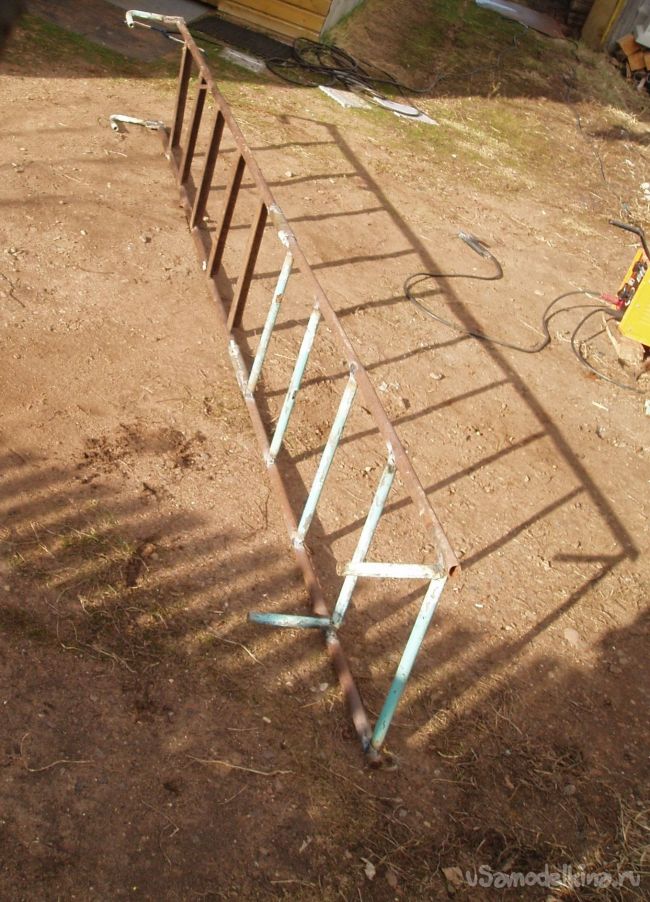

After that, a pump, a hydraulic accumulator, a pressure regulator, pressure gauges, pipes, fittings, adapters, pressure switches, and other parts necessary for installation were purchased.
Due to the fact that 99.9% of the pumps that are sold in our stores differ only in price tags and stickers, and are made at the same factory in the Middle Kingdom, the pump was chosen based on the following parameters: price, ease of connection, availability of protection and maximum term warranty.
A 700W centrifugal submersible pump was purchased, with a built-in water level sensor (frog) and a 3/4 inch connecting pipe. The maximum height of water rise is 50 meters. I do not indicate the name and brand, I am an opponent of advertising.
Something like this.

It was decided to install the system directly on the wall in the utility room of the house.
Pipes and equipment are attached to the wall with clamps.
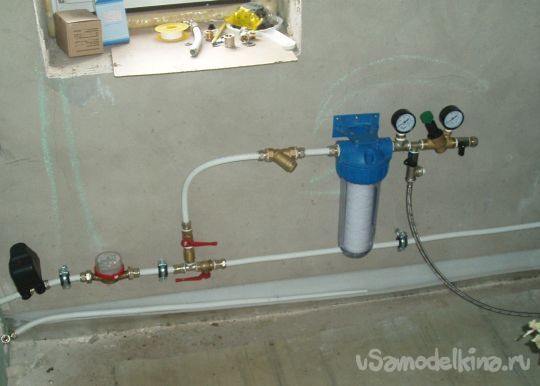
As you can see in the next photo, the entire water supply system is mounted sequentially, while the entire process of its operation is well traced. Arrows indicating the direction of water movement are marked on the meta-genital tubes with a marker. Subsequently, this greatly facilitates the operation of the system and its repair, even by an unprepared user.

On the pump itself, a check valve is installed in the well, which prevents the drainage of water from the pipes back into the well. There is also a water level sensor (frog) on \u200b\u200bthe pump, which turns off the pump if the water level in the well falls below 50 cm.
Water from the well (see photo) enters the system inlet, where a protective relay is installed to limit the maximum pressure in the system. This relay is configured to shut off at a pressure of 5 kg / cm and is installed so that the pump does not fail during overload (if the filter clogs, accidentally close the tap).
As it has been established empirically, the minimum debit of this well is 0.7..0.8 m3 per day in winter, and the maximum 2.0 ... 3.0 m3 of water in summer. What can you do, such a "waterless" place, you have to save.
Then a check valve is installed on the pipe, followed by a dry-running relay, which is triggered at a pressure in the system of less than 0.5 kg / cm, if a leak appears in the system or air enters the pipes.
Next come a coarse filter (mesh) and a fine water filter. Then a pressure gauge is installed, showing the pressure in the accumulator, then a pressure switch, and a pressure regulator. A pressure gauge is installed behind the pressure regulator, showing the pressure in the flow line going to consumers (sink, shower, etc.)
The pressure switch turns on the pump, it works if the pressure in the accumulator becomes less than 2.0 kg / cm, and turns off at 4.0 kg / cm.
A pressure regulator in this water supply system is a must. It is this device that allows you to economically use water, avoiding peak loads and draining the well. Without this device, for example, 100 liters of water was only enough for a short shower, and now you can use water for several hours before the pump turns on and starts pumping water into the system. The pressure regulator is designed to maintain in the pipes at the water consumers the minimum pressure required for their normal operation, regardless of the inlet pressure level.
It was experimentally found that 1.5 kg / cm is quite enough for the washing machine and for the shower, and this is more than enough for washing hands and working the toilet. But now, no matter how widely the consumer's tap is open, he will not be able to use more than the value of the water jet set at a level of 1.5 kg / cm. Very convenient, you know, especially for city guests who do not know how to save water.

The electrical part of the water supply system is installed in a standard dashboard with a din-rail for six positions, consists of three switches (conventional circuit breakers for 6A) and three indicators.
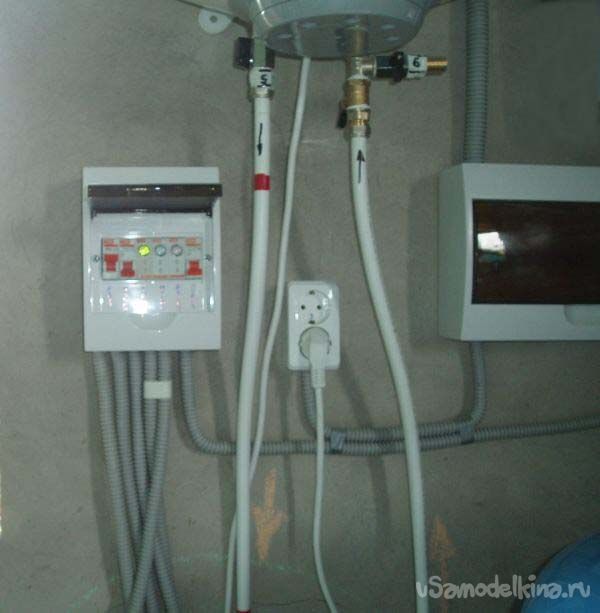
The photo clearly shows: the power switch B1, the switch for heating pipes B2, the power indicator (green), the pump operation indicator (blue), the alarm indicator (red), and the forced switch of the B3 pump (in case of pumping water or irrigation).
Here is a wiring diagram of an autonomous water supply system.

Р1, Р2 - these are the contacts of the protection relay and the dry-running relay. P3 - pressure switch, M1 - pump.
The installation of the water heater is carried out in accordance with the instructions attached to it, according to the standard scheme and has no special features. The only addition is a tap for forced draining of water from the water heater in case of repair or replacement of heating elements.
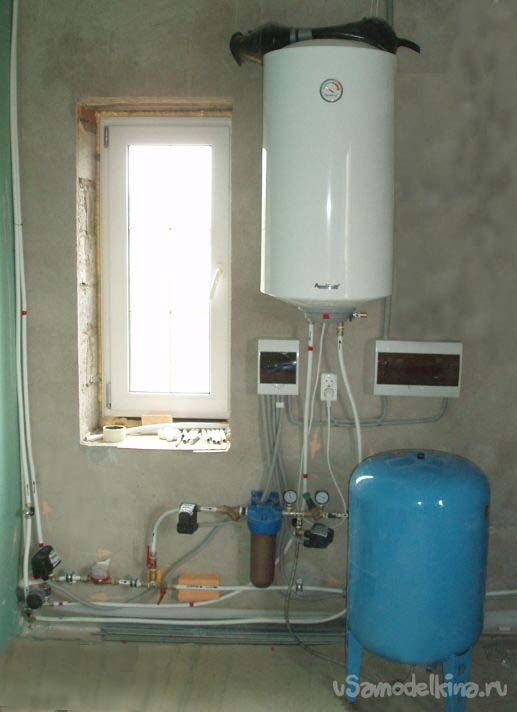
During the entire period of operation, no repairs to the water supply system were required, except for the replacement of a rubber bulb in the accumulator under warranty. The old pear after vulcanization remained in reserve. There she is, on top of the water heater.
The concept of autonomous heating is a type of heating in which the heated room either does not depend on external factors and sources, or has an individual independent source of thermal energy.
Heating system ◄ – this is a system designed for independent heating and hot water supply of premises and structures for various purposes, operating from an independent energy source. Such private house heating system is the only way to ensure comfortable living conditions in the cold season, and in the case of apartments, industrial and office premises, it relieves from a number of inconveniences associated with the central system, moreover, it is the most efficient and economical. Based on this, the following advantages can be distinguished that autonomous system :
Boiler room for a private house
Modern boiler room  Installation of water filters Gas wall-mounted boiler Boiler room repair
Installation of water filters Gas wall-mounted boiler Boiler room repair
- the ability to independently control the temperature of heating the premises;
autonomous ◄ home heating can be operated all year round;
allows you to avoid the inconvenience associated with breakdowns of the centralized system in the winter;
savings - since payment is made for actually used heat (gas, electricity);
the ability to choose an energy source - it can be electric heating, autonomous gas heating ◄, boiler fired with solid or liquid fuels.
The most common and economical is autonomous gas heating, since gas is an affordable, inexpensive and environmentally friendly fuel. For comparison - 1 kW / h costs about 0.2 rubles, while electricity - 2.42 rubles, diesel fuel - 1.72 rubles. Although, if it is not possible to connect a gas boiler, the best way out of the situation may be electric heating.
The main element that includes heating system of a private house, is the boiler. Its choice depends on the installation method (floor or wall), on the traction method (natural and forced), on the type of ignition, on the number of circuits (single and double-circuit) and on power.
Also, in the selection process, the area of \u200b\u200bthe object and its design features are taken into account.
Heating installation .
To autonomous home heating it worked efficiently, did not cause inconvenience to the owners and justified its purpose, its competent calculation and professional installation are very important. Heating calculation is compiled individually, taking into account the needs of the building for heating and its design features, as well as, based on the type of equipment installed. Heating scheme of a private house must correspond to its layout, area and type of rooms. In this way, heating installation consists of several main stages:
Implemented heating design, which is based on thermal and hydraulic calculations... Also, the project should include the equipment necessary for installation and an installation plan.
Selection of the necessary equipment that will ensure uninterrupted heating of a country house. At this stage, it is important to agree with the customer on all the nuances regarding the optimal price-quality ratio and conduct heating calculation .
Equipment set according to approved calculations.
Installation of boiler equipment. This may include the installation of pumps, filters, expansion tanks, boiler, regulating, instrumentation and other equipment.
Distribution header organization. Convenience in the process of further operation of the heating system depends on it, since the collector is responsible for the uniform distribution of the coolant throughout the system, simplifies its repair, since in the event of a branch breakdown, it can be turned off without shutting down the entire system, and also allows control over her.
Installation of piping for heating and water supply. Also autonomous heating system may include a "warm floor" system, therefore, as a material for pipes optimal solution is copper.
Connection of heating radiators, installation of water points.
Connecting the system, as well as carrying out commissioning, during which diagnostics and adjustment of equipment are carried out, defects are identified, and their elimination is carried out. The process of optimizing the operation of the system is being carried out with the entry of performance indicators into technical documentation, which is then handed over to the customer.
In this way, heating country house - this is a complex and time-consuming process that requires professionalism, knowledge and experience, therefore, only specialists should be trusted. Our company, having vast experience in this area, provides a wide range of services for connecting autonomous heating and water supply, which include:
- heating design;
heating boiler installation and installation of boiler equipment;
- organization of the pipeline and connection of heating radiators;
system connection;
commissioning works.
For all work carried out by us, we provide a guarantee.
Autonomous home heating.
Independent heating required in many cases, not only for a country house, but also for organizations.
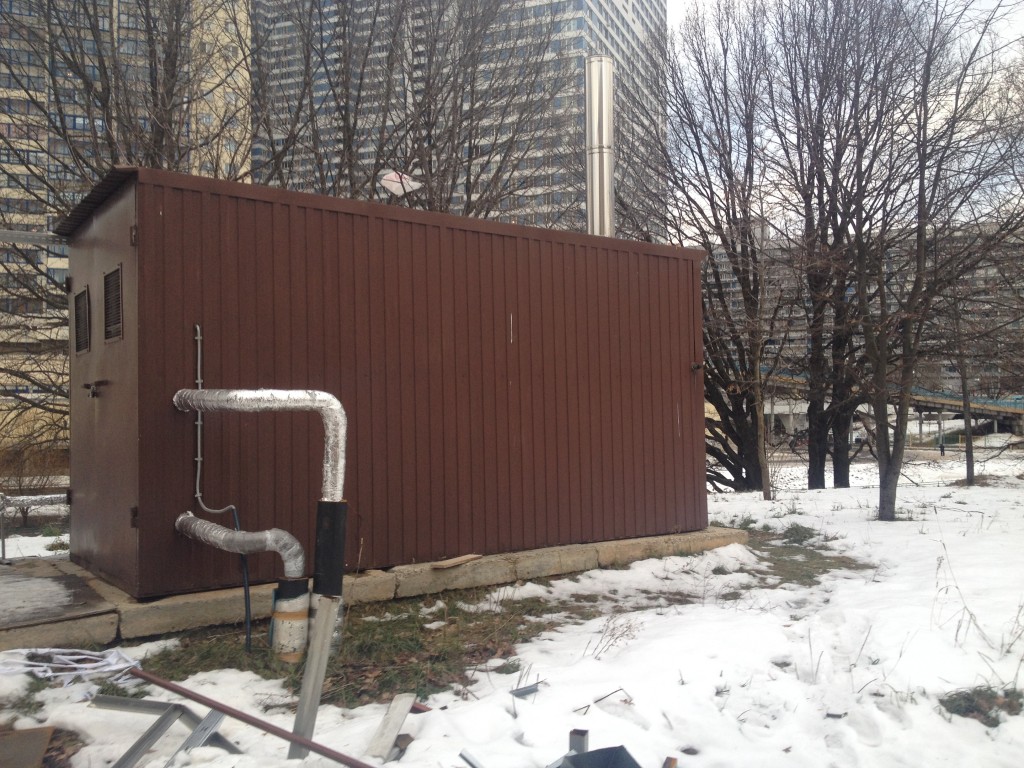
Separate heating boiler room.
More about autonomous heating let's give an example of a device autonomous heating fitness center. The problem associated with heating arose in the inability to conduct a heating main from the city heating system, and for this it was decided to install autonomous own heating.
Where to locate the heating boiler and fuel tanks. The solution was to use metal sheets and weld a small boiler room of our own using welding equipment. Since the boiler heating installed in an independent room, the heating boiler does not require dependence on other heating networks, then the boiler room device can be safely called autonomous boiler room for heating the building.
You have built yourself a country house (cottage) and it is time to install the sewerage system and water supply. When the plot is small and the family consists of two people, and the house will be used only in the summer, the water supply can easily be entrusted to a household pump. In the case of a large family and a large plot requiring watering, a water supply network should be installed to supply the country house with water. A household pumping station was created especially for autonomous water supply. The pumping station automatically supplies water under pressure to the water supply system and constantly supplies you with water day and night. It is about the benefits pump station, the principle of work and how to connect a pumping station with your own hands - will be discussed in this article.
Benefits of using a pumping station
A pumping station for a home automatically takes water from a water supply source and under pressure through pipes supplies water to a water supply source. Also, the station can increase the pressure in the water supply system. This is necessary when your plumbing system has insufficient pressure to consume. Quite often they are used in combination with a deep-well pump when the deep-well pressure is insufficient.
Advantages of a pumping station over a deep and surface pump:
- during a power outage, the pumping station will continue to supply water remaining in the accumulator;
- with the correct selection, the pumping station will create the necessary pressure;
- light weight;
- the pumping station is installed in any place convenient for you;
- the pumping station operates with periodic shutdown and inclusion, which means minimal electricity costs and low wear and tear of equipment.
Simply put - an autonomous pumping station will work for you for more than one year and will eliminate the need to carry water by hand.
Device, principle of operation of the pumping station
Surface pump with ejector
For a person who knows a little about technology, the pumping station will not be a discovery. The main structural element is a surface pump with an ejector mounted on a hydraulic accumulator. The pump is capable of pumping out water from a depth of 10 meters and supplying it to the desired draw-off point.
Pumping station
Hydraulic accumulator for pumping station
A suction line leaves the pump to the water source, at the end of which a check valve with a filter mesh is installed. The pump comes with a pressure tank (- steel or stainless steel).

The accumulator has a closed structure; it has two cavities separated by a rubber membrane. One cavity is pumped with air under pressure, and the second will receive water under the pressure of the pump. The accumulator performs the following functions:
- protection of the water supply network from hydraulic shocks;
- accumulates water under pressure in the water cavity, depending on the supply and flow rate of water, the pump is turned off for a while, i.e. in the event of a power outage, the water accumulated in the tank will be supplied to the system.
Due to the water storage property, the pressure tank was called a hydraulic accumulator. The volume of accumulators starts from 8 and ends with 500 liters.
Pressure switch
The pumping station is equipped with a pressure switch that starts and stops the pump when the pressure drops and rises to a certain level, respectively. To control the pressure, the pump is equipped with a pressure gauge in the line.

Polyethylene pipes for water supply
The connection of the pump station components is carried out using pipes and fittings. For the installation of the water supply network, for convenience, we recommend using polyethylene pipes.
The polyethylene pipe is non-corrosive, lightweight and durable. When freezing, the polyethylene pipe does not tear, it expands. Polyethylene pipes will last more than 50 years. The principle of operation of the pumping station is in pumping water from a source (well, well), creating pressure in the water supply network, water under pressure is distributed to the points of water intake.
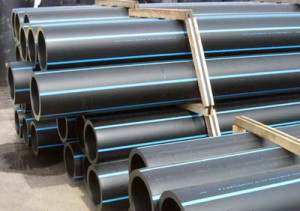
Water is pumped out of the source via a pumping station through a water intake pipe with a valve and a filter mesh and first supplied to the pressure tank. As soon as the optimal pressure in the accumulator, set on the pressure switch, is reached, the pump turns off. After filling the storage tank with water, the pump turns off, and when you open the tap, pressurized water begins to run out of it. It is the air in the second plane of the tank under pressure that maintains water in the system under pressure and pushes it into the collapsible tap. The pumping station is turned on when the pressure drop has reached the set in the pressure switch for shutdown.
How to connect a pumping station
Now you know the structure of the pumping station, we move on to the most important thing, how to connect the pumping station yourself using only your own experience and the unit's passport. In order for the station to work reliably and without interruption, we install it on a stable surface. Ideally, the pumping station is installed on concrete base, you can also fix it on a wooden board. A rigid mount using rubber as a shock absorber is mandatory. To install a pumping station, we need:
- bars 150: 100 cross-section, and the length of the bars should be at least 6 cm wider than the pumping station;
- edged board 10-15 cm wide (or 2 boards 5-7 cm wide) thickness 4-5 cm, the length of the board should exceed the dimensions of the pumping station by 8-10 cm;
- as well as sand-clay mortar 3 to 1.
On a flat surface, we make two depressions in the shape of a rectangle, the width of the rectangle is 2.5 cm and a depth of 1.3 cm. The bars are pretreated with an antiseptic and placed strictly horizontally at the bottom of the depression. The top of the bar should protrude 2 cm from the base.
The basis for the installation of the pumping station

For the bars, recesses are made opposite the fasteners at the pumping station (runners on the accumulator). We prepare a sandy-clay mixture and put it around the bars, be sure to tamp it. Boards are also treated with an antiseptic and screwed or nailed to the bars. When the solution has frozen, we install a water supply pumping station on the boards and fix it with wood grouse screws with an engraving under a cap that does not allow it to loosen during vibration.
Installation of the pumping station to the base
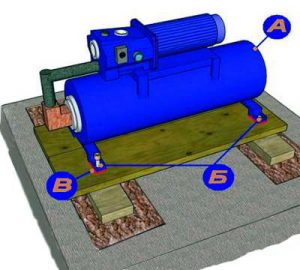
Rubber gaskets 1-2 cm thick are placed under the feet of the pumping station. This is all done to reduce vibration and noise from the station operation.
Pump station maintenance
The operation of the pumping station should be periodically monitored, and not until it breaks down. Check the presence of air pressure in the accumulator, for this you can use a simple car pump with a pressure gauge. If the pressure drops, pump it up. Factory pressure is 1.5 atmospheres. Check at which mark on the pressure gauge the pumping station starts up and at which it turns off. Factory settings enable 1.7 * (8), disable 2.8.
The membrane is washed twice a year. If the diaphragm is worn out, replace it.

The membrane can be rinsed with a solution of water and soda. The pump injector can also become dirty, you will know this when the water stops supplying to the water main. The shell is removed and the injector is cleaned.
Frequent cleaning of the injector will shorten its life. Used for cleaning sandpaper No. 80-110. The contacts in the pressure switch are cleaned at least once a year.
Prices for membranes start at 800 rubles. depending on the displacement.
Elimination of probable malfunctions of the pumping station
Congratulations, now you have installed the pumping station and know how to maintain it, now you can connect it! Malfunctions may occur during test run or further operation. Let's find out which ones and how to eliminate them.
Malfunction:
The pumping station is working, and the pressure level in the line is zero and no water is supplied.
Elimination:
completely remove air from the suction line; if this does not help, check the membrane and its fastening for integrity, straighten and install in place.
Malfunction:
The pumping station does not turn off, water is supplied with an admixture of air.
Elimination:
Check the junction of the water intake pipe and the filter for a hole in which air can enter, seal it with silicone sealant.
Malfunction:
The water does not enter the water supply, but flows out of the pump.
Elimination:
Check if the check valve is correctly installed, this is determined by the direction of the arrow drawn on the surface of the device.
How to choose a pumping station
Before choosing pumping stations for a country house or summer cottage, you should first find out the performance of your source (well, well). Performance below 1.7 m³ / h - the pumping station will not be able to provide the required pressure in the water supply system, there will be constant water supply interruptions. Therefore, when choosing a model of a pumping station, focus on the maximum productivity of your source, which should be slightly more than the productivity of the pumping station. Otherwise, your source will be constantly empty, as the pump will quickly pump out all the water from it. The required capacity is calculated by the number of taps.
The average at one point of draw-off is 0.35 m³ / h. If there are 5 draw-off points, 1.75 m³ / h is obtained. The pumping station must always be taken with a capacity margin, therefore a pump with a water supply of 2 m³ / h is required. Taking into account the water points, a hydraulic accumulator is selected. For each new tapping point, 12 liters are added. Our example is 5 × 12 \u003d 60 liters.
Pumping station for water supply at home
![]()
Pumping station Aquario
Those who have already installed a water supply pumping station leave favorable reviews about it. The water flowing into the tap automatically allows you not to accumulate water in advance and to carry it from water sources manually. Taking a shower becomes much easier. The process of watering a vegetable garden and garden with automatic water supply using a pumping station becomes a pleasure, not a punishment. If still install drip irrigation, you will have more time for other things. You can devote this time to your family!



